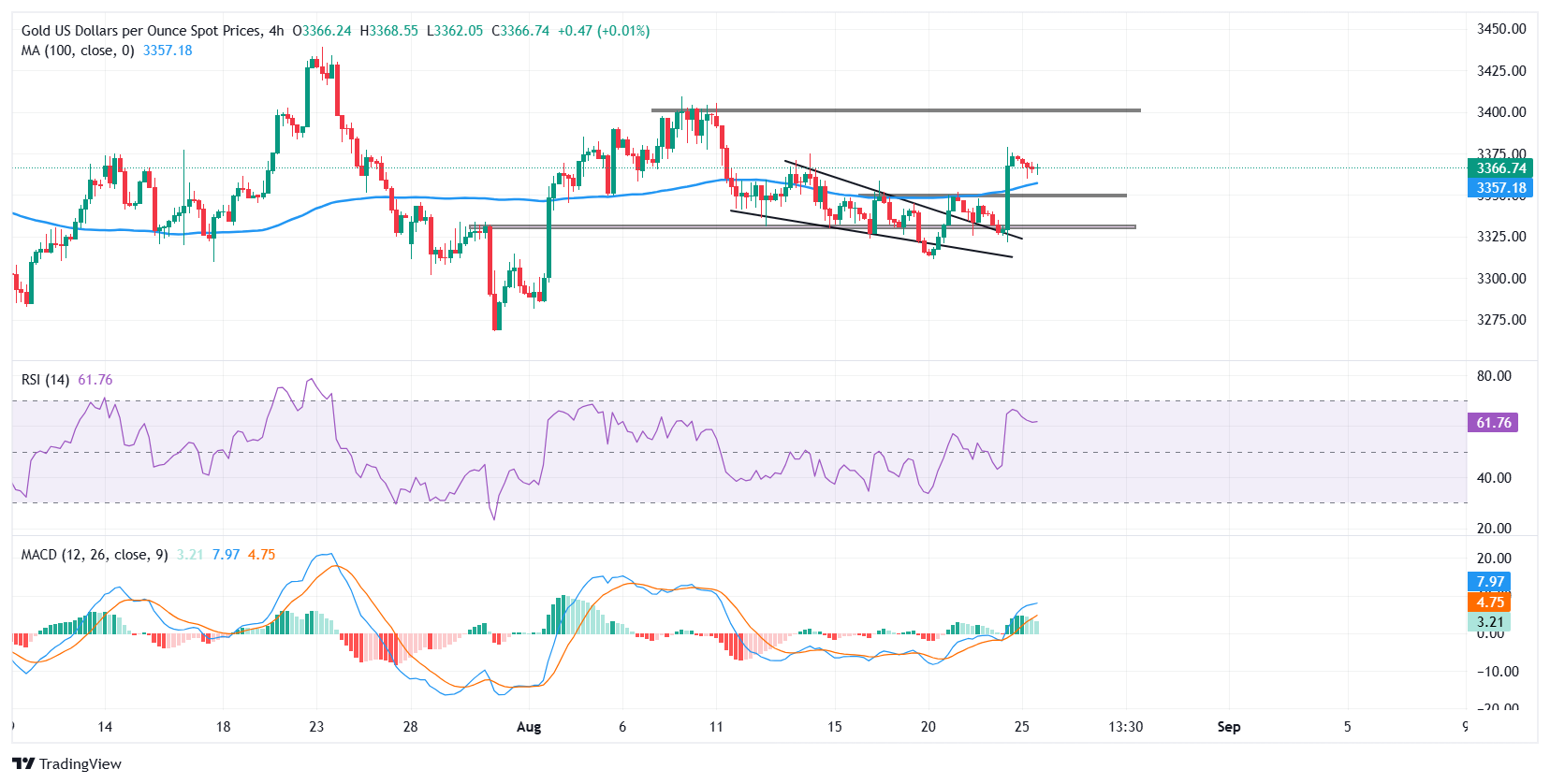Gold Steadies Near Two-Week Highs As U.S. Dollar Stabilizes

Image Source: Pixabay
Gold (XAU/USD) kicks off the week on a softer footing, pulling back slightly after touching a two-week high on Friday following Federal Reserve (Fed) Chair Jerome Powell’s dovish remarks at the Jackson Hole Symposium, which fueled a broad rally in precious metals. A modest uptick in the US Dollar (USD) and firmer Treasury yields at the start of the week are trimming bullion’s momentum, leaving the metal consolidating near recent peaks around $3,370 at the time of writing.
Powell gave his final annual speech at Jackson Hole Symposium last Friday, where he emphasized the Fed’s cautious approach to monetary policy in a shifting economic environment. “The stability of the unemployment rate and other labour market measures allows us to proceed carefully as we consider changes to our policy stance. Nonetheless, with policy in restrictive territory, the baseline outlook and the shifting balance of risks may warrant adjusting our policy stance,” Powell said. His remarks highlighted the Fed’s balancing act. Tariff-driven price pressures could be a one-off shock, but he signaled that weakening job growth and an already restrictive policy stance are becoming the bigger concern. This shift reinforced market bets that interest rate cuts remain on the table for the coming months, even as inflation risks linger.
Markets interpreted Powell’s tone as a clear dovish shift, prompting a sharp repricing of rate-cut expectations. According to Reuters, major brokerages including Barclays and BNP Paribas now expect a 25-basis-point (bps) cut in September, with some projecting another reduction in December. The CME FedWatch Tool now shows an 87% probability of a September rate cut, up from about 71% before Powell’s speech. In response, Treasury yields slipped, Wall Street rallied, and the US Dollar retreated from two-week highs, providing a tailwind for Gold.
Market movers: Markets eye key US economic data after Powell’s dovish tilt
- The US Dollar Index (DXY), which tracks the Greenback against a basket of six major peers, stabilizes after falling nearly 1% on Friday as rate cut expectations fueled broad Dollar selling. The index is hovering around 98.00 at the time of writing on Monday, attempting to reclaim lost ground.
- US Treasury yields also stabilize across the curve in the aftermath of Powell’s Jackson Hole speech. The benchmark 10-year yield holds near 4.27%, steady after falling nearly 10 basis points on Friday. The 30-year yield is seen around 4.94%, up 2 basis points, while the US 10-year TIPS hovers near 1.86%.
- Fed Chair Powell described the near-term outlook as a “challenging situation,” with upside inflation risks offset by weakening employment signals. He stressed that policy is closer to neutral than a year ago, allowing the central bank to proceed carefully. Upcoming August jobs and inflation data will be critical inputs before the September FOMC meeting.
- Powell noted that job growth has slowed sharply to just 35,000 per month over the past three months, while Gross Domestic Product (GDP) growth cooled to 1.2% in the first half of the year. At the same time, higher tariffs are now clearly pushing up consumer prices, with core Personal Consumption Expenditures (PCE) inflation expected to accelerate to 2.9% in July from previous 2.8%.
- Geopolitical tensions stay in focus after Russia accused Ukraine of drone strikes on a nuclear power plant in Kursk, even as Washington signaled Moscow may be open to concessions in peace talks. Adding to the diplomatic dimension, German Vice Chancellor Lars Klingbeil said Berlin will join efforts to provide security guarantees for Kyiv, stressing that Ukraine must lead any negotiation process.
- A busy US economic calendar lies ahead. Monday brings US New Home Sales alongside remarks from New York Fed President John Williams. On Tuesday, attention turns to Durable Goods Orders and Consumer Confidence. Thursday features the weekly Initial Jobless Claims, plus preliminary readings of GDP and PCE. The highlight comes Friday, with the final report on PCE inflation — the Fed’s preferred inflation gauge — together with the University of Michigan survey on Consumer Sentiment and 1-year and 5-year inflation expectations.
Technical analysis: XAU/USD clings to two-week highs, bulls eye $3,400
(Click on image to enlarge)

XAU/USD confirmed a breakout from the falling wedge pattern on the 4-hour chart last week, retested the broken resistance, and then surged to a two-week high of $3,378 on Friday. The move validated the bullish reversal structure and highlighted renewed buying interest after a period of consolidation. At the time of writing, the metal is trading near $3,370, holding above the 100-period moving average at $3,357, which is acting as immediate support.
Momentum indicators remain supportive of the bullish bias. The Relative Strength Index (RSI) is holding around 61, showing that upward momentum is intact without entering overbought conditions. The Moving Average Convergence Divergence (MACD) histogram is positive, and the widening gap between the MACD blue line and red signal line suggests that bullish momentum still has room to extend.
Overall, gold’s breakout-retest sequence keeps the technical outlook tilted to the upside, with the bias remaining bullish above $3,350. Sustained gains over $3,380 would reinforce momentum toward $3,400 and beyond, while a drop below $3,350 would risk pulling the metal back into a broader consolidation phase.
More By This Author:
EUR/USD Retreats As The Market Digests Fed Powell's Dovish Turn
Canadian Dollar Weakens To Three-Month Low Despite Upbeat Retail Sales
AUD/USD Price Forecast: Below 0.6415, The Pair Might Fall To 0.6375



